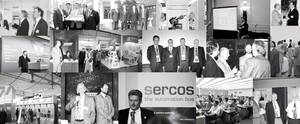Into the future with tradition and innovation
25 years of Sercos International – 10 years of Sercos III: A review
Digital intelligent drives offer the highest precision and speeds for numerically controlled machines, at the same time minimizing equipment costs. In order to benefit from these advantages, an efficient digital interface is required for control. Although Sercos was originally designed as such an interface, over the course of the last two decades Sercos has developed into a universally deployable real-time interface for all automation applications.

Sercos History
The Sercos story goes back to the mid-1980s. In the fall of 1985, the ad-hoc machine tool interface working party of the VDW (German Machine Tool Builders’ Association) and the ZVEI (German electronics industry association) approved a revised version of the “machine tool drive signal interface”, better known by the name +/-10V interface. At the time, this was the only standardized interface for combining numerical controls with speed-controlled drive units. Using an A/D converter, the digital target speed on the NC side was converted into an analog signal and then was processed further on the drive side, either on an analog basis or digitally again by means of reconversion. In order to overcome the numerous weaknesses of analog technology (including high fluctuation voltages, limited resolution, offset and a lack of communication between NC and drive), some machine tool manufacturers were already working with the first digital solutions based on the RS-232 interface. However, it was clear to the initiators of the “Digital Drive Interface” working group that the correct and future-oriented solution had to be a digital bus system. For this solution, a requirements document first had to be written that summarized the current problems and visions. An expert team of machine tool manufacturers, drive manufacturers and control manufacturers set to work and the Sercos interface concept came into being as the first digital bus system between the control and the drives.
The Sercos User Organization
In 1988, the concept was established, along with the clock-synchronous transfer concept, the most important profiles and the desire to offer an ASIC as the basis for the master and slave interfaces. Money was needed for this, so in 1990 Fördergemeinschaft Sercos interface (FGS) was founded. Its members undertook both financing the Sercos concept and also supporting it for the future. Today, this syndicate collaborates on an international basis under the umbrella of Sercos International e.V.. As an association of users, manufacturers and research institutes, the user organization is responsible for the technical development, standardization, certification and marketing of the Sercos technology. Conformance tests in the user organization’s test laboratories guarantee that Sercos implementations are standard-compliant ensuring that devices from different manufacturers can be combined.
Based in Germany, the organization presently has more than 90 member companies located around the world and has national liaison offices in North America and Asia.
The three Sercos generations
The first generation, which was presented to the public for the first time at the EMO show in Hanover in 1989, supported 2 and 4 Mbit/s transmission rates and initially was used mainly in demanding tool machine applications. In the following years, Sercos was successfully deployed in a wide variety of applications around the globe and in a wide variety of applications and industries. In 1995, Sercos was recognized as IEC standard 61491.
In 1999, the second generation of the standard followed. The transmission rate was increased to 8 and 16 Mbit/s, a new ASIC was developed, and the service was expanded to include asynchronous data transmission. Since 2001, this technology has been available based on the SERCON816 ASIC, with backward compatibility with the first generation ensured.
The recipe for success of Sercos III, the third generation of Sercos, which was launched into the market with initial prototypes in 2005, is: “Use of the transmission medium and the protocol of Ethernet while preserving the tried-and-tested Sercos mechanisms.” The combination of these two technologies creates new, innovative opportunities for the automation technology of the future.
| Milestones | |||||
|---|---|---|---|---|---|
| 1985: | “Machine tool interface” ad-hoc working group | ||||
| 1989: | Presentation of the Sercos interface at the EMO (European Machine Tool Show) in Hanover, Germany | ||||
| 1990: | Foundation of Fördergemeinschaft Sercos interface (FGS), now: Sercos International. Founding members: ABB, AEG, AMK, Bosch, Indramat and Siemens. | ||||
| 1990: | First Sercos test laboratory at Technical University Darmstadt, Germany | ||||
| 1994: | Foundation of Sercos North America | ||||
| 1995: | Recognition as international standard IEC 61491 (SERCOS I) | ||||
| 1998: | Foundation of Sercos Japan | ||||
| 2001: | New test laboratory at ISW, University of Stuttgart, Germany | ||||
| 2002: | Adoption of edition 2 of the international standard IEC 61491 (SERCOS II) | ||||
| 2003: | Start of development of Sercos III | ||||
| 2005: | 20-year celebration at the EMO in Hanover, Germany | ||||
| 2006: | Cooperation between Sercos International and the ODVA to develop CIP Safety on Sercos | ||||
| 2007: | Recognition of Sercos III as an international standard (IEC 61784/61158 and IEC 61800-7) | ||||
| 2007: | 2 million Sercos real-time nodes installed worldwide | ||||
| 2007: | Opening of a branch in China | ||||
| 2008: | Cooperation between Sercos International and the FDT Group for FDT/DTM annex for Sercos III | ||||
| 2010: | 25 years of Sercos technology | ||||
| 2015: | 25 years of Sercos International – 10 years of Sercos III |

